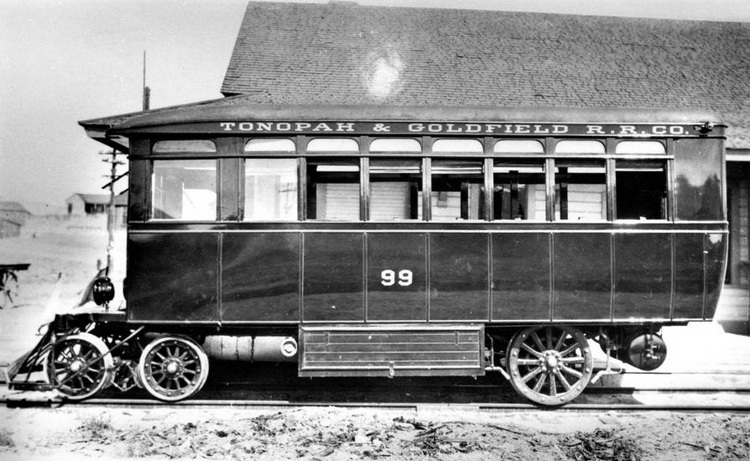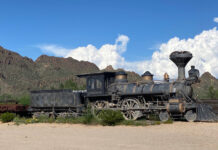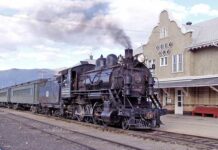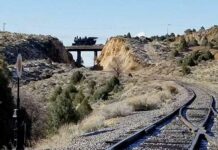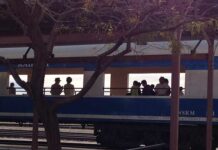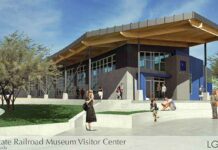By Stephen E. Drew, Chief Curator (retired) California State Railroad Museum
|
|
The self-propelled passenger car, or motor car, was the savior of early 20th-Century railroad branches and short lines, especially in Nevada. In place of a full-crew steam train carrying freight, passengers, baggage, mail and express, a motor car combined these into one economical vehicle operated by a crew of one or two — and could pull a passenger coach or a couple of freight cars besides.
Self-propelled passenger cars kept low-volume rail lines in operation, forestalling further service reductions or eventual abandonment. This three-part series takes a look at 28 passenger motor cars on ten Nevada railroads, emphasizing the state’s short lines and the surviving passenger motor-car collection at the Nevada State Railroad Museum.
Tonopah & Goldfield Railroad
A new silver discovery in mid-1900 touched off a renaissance in southern Nevada gold and silver mining and
associated development. The Tonopah & Goldfield Railroad emerged in November 1905 as a consolidation of the Tonopah Railroad and the Goldfield Railroad. The railroad extended 60 miles from Tonopah Junction on the Southern Pacific down to Tonopah in Nye County and 31 miles farther to the new boomtown of Goldfield in Esmeralda County.
The T&G was an early user of motor cars. In a December 14, 1908, letter to the Sierra Railway of California,
T&G Superintendent of Motive Power A.B. Phillips remarked that the Nevada line had three motor cars:
Fairbanks, Morse roadmaster’s inspection car that could carry three people, a small car built at Tonopah that could carry four, and a four-cylinder, 30-horsepower Oldsmobile that had been converted for rail use.
Phillips noted the car seated five nicely, and could accommodate as many as eight. It exhibited good power up a 4-percent grade, ran well at up to 40 miles per hour and averaged 12 miles per hour on the road. In 1921 the T&G purchased motor car No. 99 (photo above) for $8,150, primarily for use between Goldfield and Tonopah. The Thompson-Graf-Edler body was mounted on a six-wheel White Company frame with a four-cylinder White engine. The car had a capacity of 22 passengers.
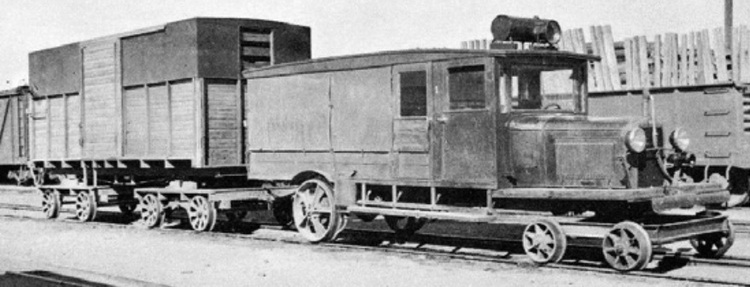
A decline in mining and general business activity ushered in a net loss for the T&G in 1926 – the first in the company’s history. Motor car No. 99 was sold in May 1926 to the nearby Virginia & Truckee Railway for $3,400, where it retained its T&G roster number and operated until 1938. On the T&G, the motor car had operated only 14,000 miles in five years, or fewer than 230 round trips between Tonopah and Goldfield.
Finally, two ex-Wheeling & Lake Erie passenger-RPO-baggage cars, W&LE No. M-103 (above) and M-102 were purchased in 1934 and 1935. The cars were built by the J. G. Brill Co. of Philadelphia in 1927, and had 250 horsepower GE engines. The cars retained their W&LE numbers on the Tonopah road. The 46-ton cars held 18 passengers each and remained in service until abandonment of the Tonopah & Goldfield in October 1947. Afterwards, both cars were scrapped. The T&G also had a 3,000-lb. 1931 Brookville motor car (photo above) mounted on a Ford truck.
Tonopah & Tidewater Railroad
The sole T&T motor car, No. 99, arrived for the railroad’s last 11½ years of operation. The company had been incorporated in 1904 in New Jersey and was financed and controlled by the Pacific Coast Borax Co. of Francis Marion “Borax” Smith. When car No. 99 was purchased in December 1928, the T&T was operating 169 route-miles between Beatty in Nye County and its connection with the Santa Fe Railway at Ludlow, California.
With declining revenues, the T&T ceased operations in October 1933 over the 25.7 miles south of Crucero, California, where it connected with the Union Pacific’s LA&SL line. At the time, No. 99 made three trips a week and a mixed train operated weekly.
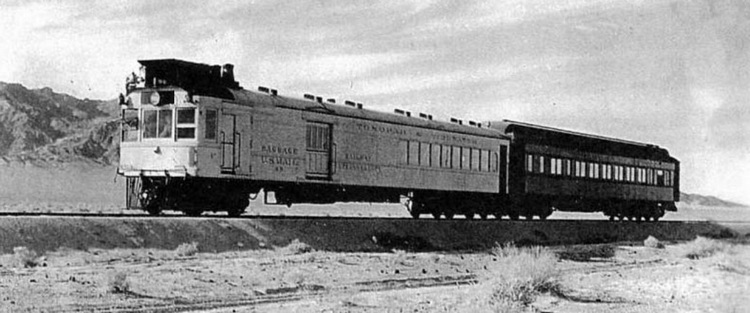
No. 99 was built in 1928 for GM’s Electro-Motive Corp. by the St. Louis Car Co. Its six-cylinder Winton engine developed 275 HP. The steel-bodied, baggage/RPO/express passenger car came to the T&T secondhand. As the photo shows, the motor car regularly hauled a standard Pullman sleeper from Los Angeles in an attempt to
develop Death Valley as a tourist destination. Upon the road’s abandonment, T&T car No. 99 was sold to the Sonora-Baja California Railroad in Mexico. where it became SBC No. 2501 and was in pay-and-supply-car service as late as 1966.
Death Valley Railroad
Although nearly all of the trackage of the Death Valley Railroad was in California, the line built a four-mile extension into Nevada to reach clay deposits located near Ash Meadows in Nye County about 1916.
The narrow gauge railroad also briefly had a Brill motor car during the last several years of the short line, although it is unlikely the car ever operated on the DV’s short trackage in Nevada.
The Death Valley Railroad was another project of F.M. “Borax” Smith’s Pacific Coast Borax Co. Incorporated in January 1914, the 36-inch gauge line ran about 20 miles from mines at Ryan, California, to Death Valley Junction on the Tonopah & Tidewater.
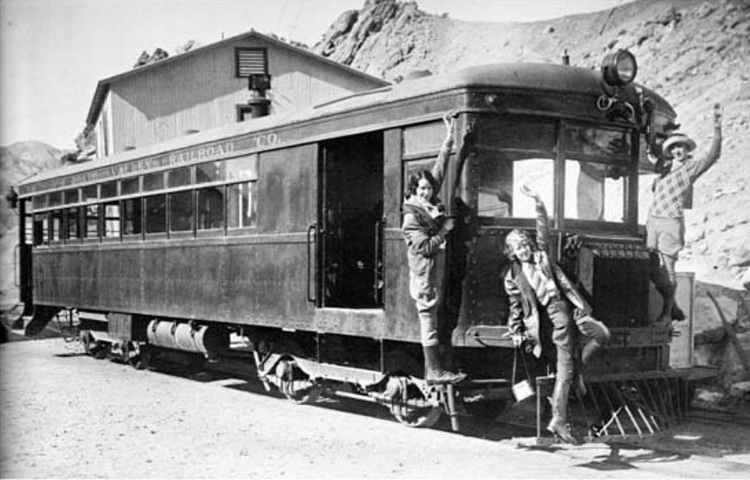
After borax mining had subsided at Ryan, Pacific Coast Borax attempted to promote Death Valley as a tourist destination from October to May of each year. Death Valley motor car No. 5 was a passenger and baggage car built in 1927 by the J.G. Brill Co. Tourism to Death Valley dropped dramatically during the Depression, mining activity subsided, and the Death Valley Railroad ceased operation March 15, 1931. The narrow-gauge motor car was sold along with DV’s two steam locomotives to the U.S. Potash Co. at Carlsbad, New Mexico. The car was used to transport potash workers and light items. It last ran in 1956 and was retired at Carlsbad.
Subsequently, car No. 5 was donated to the Laws Railroad Museum, which is operated by the Bishop Museum & Historical Society, just north of Bishop, California. It arrived at Laws in November 1967 and sat on display for more than twenty years. Between 1999 and 2004, museum volunteers restored the motor car to operating condition. Painted green and lettered as Death Valley Railroad No. 5, the motor car is believed to be the only surviving narrow-gauge Brill car in the United States.
The Trunk Lines
The country’s great transcontinental railroads also operated passenger motor-cars at various times in Nevada. These included the Union Pacific’s Salt Lake Route through Las Vegas, and the Southern Pacific and Western Pacific railroads out of Reno. The motor cars were used on branch-line as well as mainline trackage.
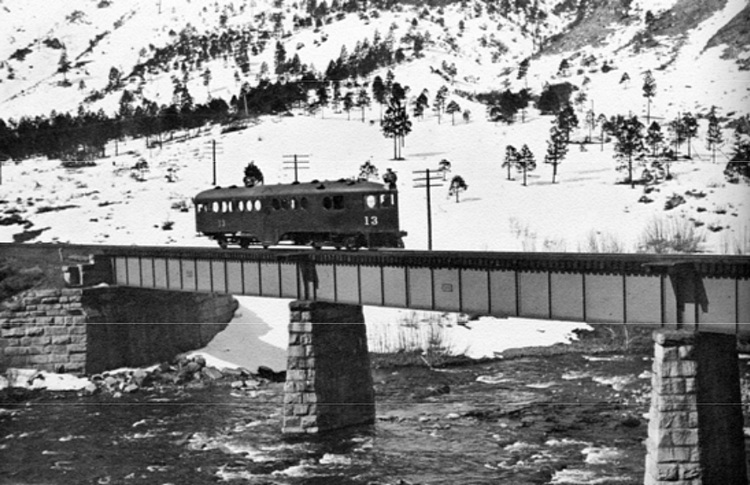
For several years around 1910, SP operated one of its new McKeen motor cars – often No. 13, built in 1908 – between Sparks and Truckee, as in the photo above. Around the same period, the company briefly operated a McKeen car between Reno and Fallon, Nevada.

The Western Pacific tried two motor cars – Nos. 198 and 199 – around 1928 on the Reno Branch. The cars were built in 1922 by the Service Motor Truck Company of Wabash, Indiana.
Finally, two Western Pacific “Zephyrette” Budd Rail-Diesel-Cars offered tri-weekly passenger service from September 1950 to October 1960 across northern Nevada. The RDC-3s, Nos. 375 and 376, were built in 1950 by the Budd Company of Philadelphia.
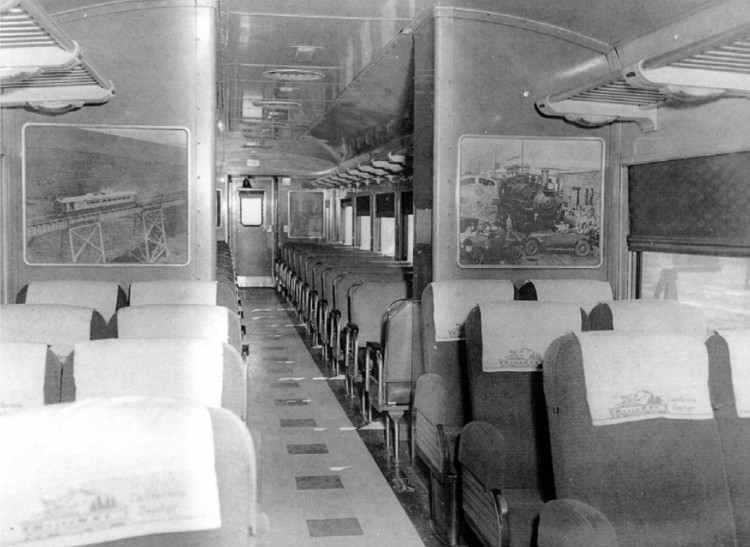
Motor Cars in Nevada Today
For more than thirty years, the only motor car to operate regularly in the State of Nevada has been former Tucson, Cornelia & Gila Bend Railroad No. 401. The steel car was built in 1926 by the Edwards Railway Motor Car Company of Sanford, North Carolina. During 1976, the car operated on Bob Gray’s restored Virginia & Truckee Railroad out of Virginia City lettered as the Washoe Zephyr. The car was purchased by NSRM in 1988. Restored to its TC&GB livery in 1999, the car operates weekends, May through September, at the Museum. Tom Gray, son of Bob Gray, is meanwhile in the process of restoring another Edwards motor car, which will go into service on the Virginia & Truckee Railroad in Virginia City when restoration is completed.
On May 9, 2010 the Nevada State Railroad Museum in Carson City restored 1910 V&T McKeen motor car No. 22 to service. The Museum operates the McKeen Car on special occasions, including Independence Day and Nevada Day.
Conclusion
For more than 60 years, nearly three dozen passenger motor cars have operated on many Nevada short lines, branch lines, and portions of the mainlines of larger railroad companies operating within the state. Motor cars were largely conceived to provide economical passenger, mail, baggage, and even express service on lightly traveled lines and to augment expensive, full steam-train operations.
For decades, motor cars were a dependable part of everyday passenger travel in Nevada. But with the rise of paved highways and the increase in private automobiles, use of motor cars in Nevada has ceased except for Museum operations. Still, “doodlebugs” and gasoline motor cars remain an indispensable component in the story of historic railroad passenger travel in the State of Nevada.
Railroad Motor Cars of Nevada – Part I Railroad Motor Cars of Nevada – Part II




